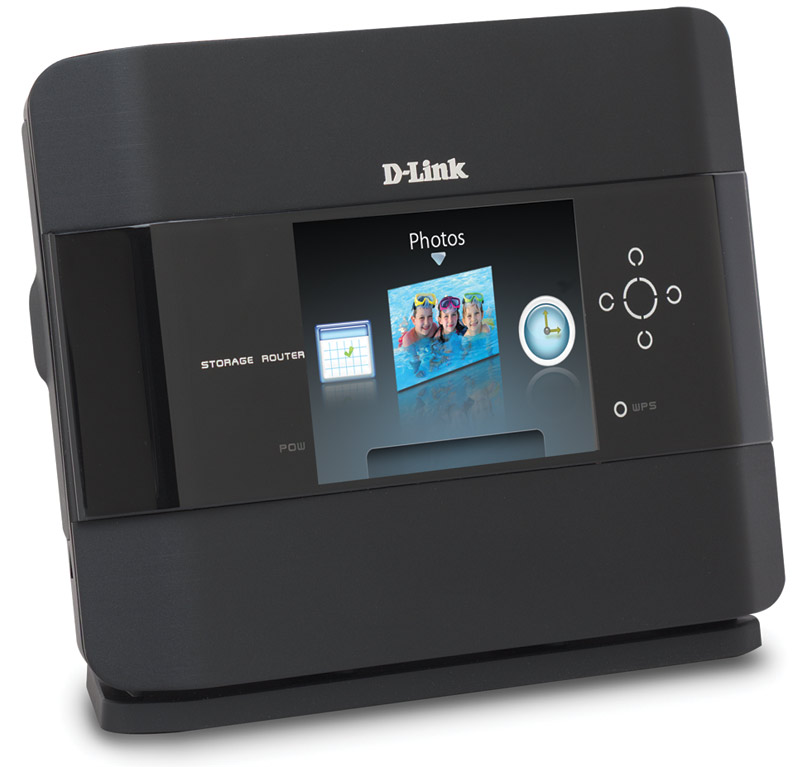Wireless Networking: Nine 802.11n Routers Rounded Up
D-Link DIR-685
Give D-Link points for creativity. A router that serves overtime as a photo frame? Sure, why not? It’s already on the network. And if you thought the LCD display on Belkin’s N1 Vision was cool, D-Link’s widgety-looking 3.2" LCD on the DIR-685 ($209.99) is downright futuristic. The question is whether you think a 3.2" display—roughly the size of your palm—makes a practical, viewable photo frame within your environment. If not, then you’re probably back to using the display for router control...if you use it at all.
Fortunately, there’s a lot more to the DIR-685 than being a quarter-sized photo frame. While there’s no external switch for an easy short-cut, you can still configure the router’s options to turn it into an access point. There are menu options for configuring Internet access via a 3G USB adapter, as well as QoS support for specifically optimizing VoIP and streaming traffic.
Of course, the headline feature of this unit is that it’s a “storage router.” Normally, that means the vendor integrates a USB port or two and provides remote access to USB-attached storage. D-Link gives you two USB ports but then takes the unique step of adding a 2.5" hard drive bay into one edge. You could plant a top-end drive in that bad boy and have yourself 640GB or more of instant network-attached storage accessible by up to 64 user accounts or general FTP. With only one internal drive, there’s obviously no RAID support, so use this drive for redundant data you want easily accessible for outsiders, not as your primary storage location.
Other hot router features include a UPnP server and iTunes server for media streaming to compatible players on the LAN. The seemingly obligatory BitTorrent download manager is present (this requires a 2.5" HDD to be installed). We like that the DIR-685 can email alert and firmware patch messages to the admin. And yeah, getting LAN, WAN, and wireless performance speedometers on the LCD (and several other widgets besides) is still pretty cool, too.
D-Link did the right thing by putting four gigabit ports in place, although that’s pretty much expected at this price point. And for the price (which still shows as $299.99 on D-Link’s site), we would have expected 2.4/5.0 GHz dual-band support. As it is, the DIR-685 is 2.4 GHz-only, which seems a gaping oversight for a supposedly media- and streaming-savvy router. On the other hand, we dig D-Link’s SharePort feature, which makes attached USB devices appear as local assets to client systems running D-Link’s SharePort software. For these and several other small but useful perks, we found the DIR-685 to be one of this roundup’s most intriguing routers. If nothing else, it sets a positive example for the networking industry in how to innovate for a more experienced consumer audience.
Get Tom's Hardware's best news and in-depth reviews, straight to your inbox.
-
deividast I want one of those Linksys :) I use now WRT54G and it's doing it's job, but it's a bit slow some times then transfering files from notebook to PC :)Reply -
vant I'm surprised the 610N won. Without testing, the general consensus is that Linksys sucks except for their WRT54s.Reply -
The testing is flawed in that there could be great variability in adapter performance, as admitted by the author. A true "router" comparison would use a common non-partial built-in Intel wifi link miniPCIe card to isolate router performance. Otherwise, too many variables are introduced. Besides, most ppl buy routers for routers, not in matching pairs since most ppl already own wifi laptops or adapters. Smallnetbuilders tested the Netgear WNDR3700 as one of the best performing routers on the market. Obviously this review unit is hampered by the Netgear adapter.Reply
-
vant kevinqThe testing is flawed in that there could be great variability in adapter performance, as admitted by the author. A true "router" comparison would use a common non-partial built-in Intel wifi link miniPCIe card to isolate router performance. Otherwise, too many variables are introduced. Besides, most ppl buy routers for routers, not in matching pairs since most ppl already own wifi laptops or adapters. Smallnetbuilders tested the Netgear WNDR3700 as one of the best performing routers on the market. Obviously this review unit is hampered by the Netgear adapter.Good point.Reply -
cag404 I just replaced my Linksys WRT600N with the Netgear WNDR3700. I have not used the WRT610 that is reviewed here, but I can say that the difference in routers is noticeable. The reason I replaced the router was that the WRT600N was dropping my port settings used to provide remote access to my home server, and I got tired of it. Wanted to try a different router so I went with the Netgear based on a favorable Maximum PC review. Glad I did. It has a snappier feel and I get a stronger signal throughout my two-floor house. The Netgear has not dropped my port settings for my home server yet. Also, I didn't like that fact that Linksys abandoned the WRT600N with no further firmware updates after about the first or second one.Reply -
pato Was the Linksys the V1 or V2 variant?Reply
Which firmware was installed on it?
I have one (V1), but am very unhappy about the signal range! I have it replaced with a WNDR3700 and have now a twice as strong signal as before! -
Would have been nice to see the WAN-LAN throughput/connections as well for wired connections, but I guess all people but me use wireless for everything nowadays...Reply


